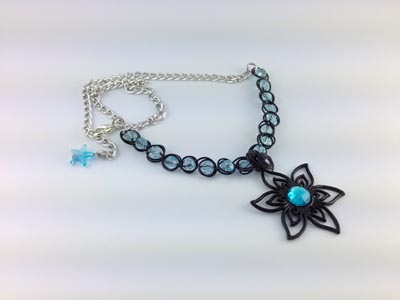I've relied on natural light photography for years. But I can't always shoot in the day because of my busy schedule or the day is just too overcast. I also have to shoot tutorial pictures in my basement beading room which has no windows. So the only recourse is to go for and improve my artificial light photography. Here are my experiments for white backgrounds which are the hardest to get right.
I resisted doing artificial light photography mainly because I didn't want to spend on studio lights. A set up I saw in Henry's camera shop would have cost well over $300. So I bought a couple daylight CFL (Compact Fluorescent Light) bulbs from Home Depot to go with a couple of old angle poise lamps I had.
My angle poise lamps can take up to 100w bulbs. Always check to see what the limits are for any desk lamps you choose to use.
As you can see, I used both of the angle poise lamps on either side of my
Modahaus TS320 Tabletop photo studio AND my little OTT Lite!
I also used the light tunnel with the shiny side inside which helps keep the light bouncing within the tunnel. Here are the results with just cropping, no photo editing. If your picture has a yellowish cast to it,
try using the white set function of your camera as I did here.
Even with my exposure compensation adjusted both are still bluish and dark. The necklace image taken with no light tunnel had a darker background but was not as washed out as the one taken with the light tunnel. Both situations can be corrected in a photo editor. On balance, I think I prefer the one without the light tunnel although there was blue color bleed with the small crystals. If I were willing to spend even more time in Adobe Photoshop Elements, I might have gotten rid of it.
 |
| No light tunnel |
 |
| With light tunnel |
Neither though were great as far as the chain area goes. Not very defined. Wishy washy. I probably need to experiment more with light placement. Maybe with my camera settings as well.
The natural light photograph of the same necklace below was better overall. All I had was the Modahaus unit with the smartcase, the best camera settings I could have on my camera and just a quick crop and a little lightening in a photo editor. A lot faster than fiddling with lights and spending more time on photo editors.
 |
| Natural light |
I also tested out my iPhone 5 using the camera + app with the lights. See the darker bands in the raw shot below? There was insufficient light. (I suspect the latest iPhone 5s with its bigger sensor will perform better.) So I experimented with the app settings - there aren't many - and the "flash" icon lightened the shot enough for the bands to disappear. I remembered not to use digital zoom - I just cropped. Digital zoom is not the same as optical zoom.
 |
| Raw photo with iPhone 5 and light tunnel |
A quick adjustment in the photo editor to get a whiter background and viola!
 |
| iPhone 5 and light tunnel |
There was so little fiddling needed with the iPhone camera because it has awesome AWB (auto white balance) capabilities. Really easy to use for those who are not accomplished with regular cameras. A time saver for busy artisans. dSLRs are superb cameras but they have a lot of settings to adjust to get good photos.
Would I use artificial light photography in the future? Yup. With my iPhone 5. If you have the iPhone 4 or the 4s, they are still pretty good as shown
in this Modahaus post. If you have the iPhone 5s, I am officially green with envy.
Before You Go:
______________________________
Original Post by
THE BEADING GEM
Jewelry Making Tips -
Jewelry Business Tips
